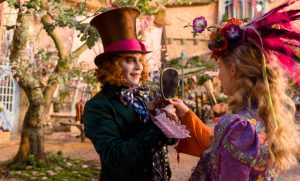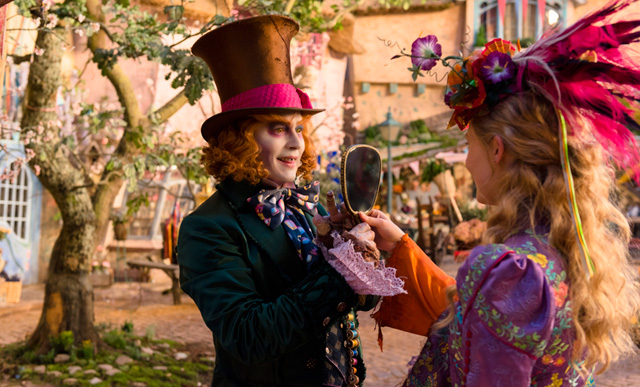Tim Burton’s “Big Eyes” is based on the real-life case of Walter Keane, who said he was responsible for the hugely successful “big eye” paintings of children in the 1960’s, and his wife Margaret Keane, who, as determined in a court case, really painted them. It is a haunting story with an appropriately haunting theme song, co-written by singer Lana Del Ray and her frequent collaborator Dan Heath. He talked to me about how they worked together and what he learned from writing for reality television.
This is a story that began with an image and then became a drama and then you take it into a third dimension with music.
It began with Lana singing a melody into my voice memo on my iPhone. And then I took that and started building on it after having seen the film because I wanted it to blend in with the score by Danny Elfman as well and be a bit seamless. And I started building up chord changes, and the progression, and the textures and the layers and the strings and the bass and all that stuff based on the melody she was singing. And really my favorite part of the song is the bridge where it sort of breaks down and she ends up saying “it’s amazing what women in love will do.” It’s such a pretty part because it’s a kind of descending pizzicato line and then it kicks back into this sort of epic chorus. But it was really nice to get to make the chorus so big because it’s quite dramatic and I like the dynamic range of the pieces. It was subdued in the verses and sort of explodes into this sort of epic thing in the chorus where she’s singing “with your big eyes and your big lies.” The process of writing was actually really good fun. We got quite a bit of creative freedom on it as well so there weren’t too many boundaries and it felt like we just got to do what we love to do which was amazing.
How did the score influence the way that you composed or orchestrated the song?
I’m a massive Danny Elfman fan and I’m a huge Tim Burton fan as well and I think whatever those two get involved together is just magic. And so that was a good place to start. Listening to the score, I did get different cues from different parts of the movie. It wasn’t like I was sort of referencing. I just sort of got a vibe from it and feel from it and based on that vibe and feel, I definitely got a lot of inspiration from the film and the music in the film.
What was the first instrument you ever learned how to play?
Piano actually. I started playing by ear when I was around five or six and when I was a bit older I started taking lessons and then got pretty serious about playing piano and really just getting good at it. By ten I think I was disciplined enough to practice six hours a day. That’s was the first instrument that I learned how to play and that’s what I write on today. My piano skills just aren’t what they used to be but I still compose on the piano.
Did you grow up in a musical family?
My dad is not really that musical but he got me into a lot of good music when I was growing up. He got me into the Beatles and the Who and the Kinks and Abba. My mom was a classically trained pianist as well so she had more music on her side. I have to say that there was always a lot of music going on at home when I was growing up and I also got to see a lot of musicals growing up as well like “Phantom Of The The Opera” and Cats and “Starlight Express” and “Les Mis” and I always really enjoyed going to those things because they are really cool. And I went to a music oriented school when I was growing up as well. I was in the orchestra and I played a lot of classical music back then as well sort of like rock from the 60’s 70’s and 80’s music. I got introduced to Led Zeppelin when I was about 12 years old and that flipped my world upside down because it was incredible music. It still is. The first album I ever bought was that Batman soundtrack which Prince did a lot of songs on. And I used to listen to that like every night before going to bed I liked all the song and then I loved Guns n Roses Appetite for Desctruction. The first album that really just like sent me into a different place was Led Zeppelin IV, which was just incredible.
How did you start working with Lana Del Rey?
She used to go out with my best friend in the world about 10 years ago. I was living in Boston going to school at the time and I would go down and visit them in New York and that’s how I met her. And then over the years we stayed in touch and she used to play me bits and pieces of music she was working on and I used to play her bits and pieces of music I was working on. And then one day before she signed her record deal with Interscope we wrote one of her singles called Bluejeans and it was our first writing experience together ever. So it was a real success that we got to write that and it did so well and that sort of launched me into the songwriting world.
When you’re working with her are you thinking about her voice? Are you gearing it for her?
Totally yes, the stuff I write for her is different from the stuff I write for anybody else. I think the stuff I write for her has got a lot more of a cinematic feel, and it’s very magical and very ethereal and very emotional. I have just been working with her for a few years now, so I think I’m starting to get what she likes and what she doesn’t. But normally like if I really like something, she really likes it too which is really cool. It is great because we’re a good team.
You did cues for reality shows for a while, right?
I was very grateful for it at the time. You know, getting to do music and getting paid for it as well. It kept the lights on and it kept the rent paid.
I would imagine that it was actually quite a learning experience.
It did get my technical chops up a lot on how to deliver styles. It’s definitely worth a lot doing it. I was writing about three or four pieces of music a day sometimes in all sorts of different styles. There is comedy, there is tension, there is suspense, there is action and all that sort of stuff. You are turning out cues so quickly that I definitely learned a lot. I would say especially in the work ethic area, just knuckling down for a good ten hour day writing music.
It did the job and it was a great learning experience too and as I said before I’m extremely grateful that I had that because it did keep the lights on and did enable me to write music, get paid and also focus on my own stuff when I wasn’t doing that.
What are you working on next?
I’m working on my own EP right now which is really cool. I’m doing four tracks and all of them are going to be quite film-score-y but all of them are going to have original vocals and melodies and I’m working four different singers for each track. And so I’m really excited about that. I’m also going to be working on Lana’s new album. And I’m working with these very different singers, trying to get some good songs oout of the door. And hopefully I’m going to be doing a film this year as well, my own film, which I would love to do I am not sure where or how yet but that’s my hope.



